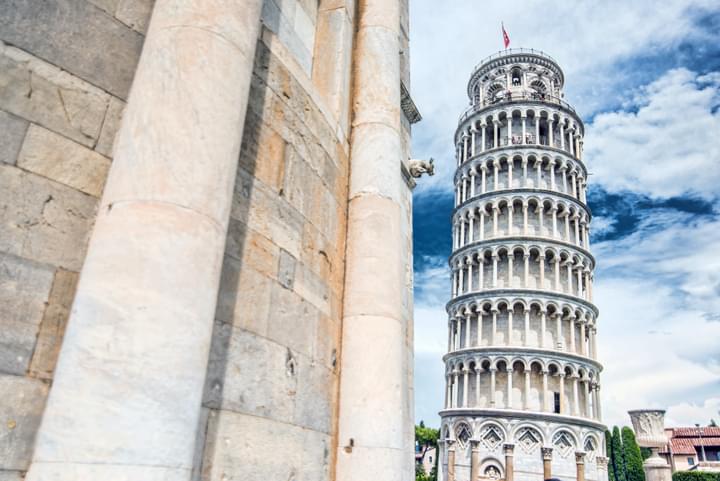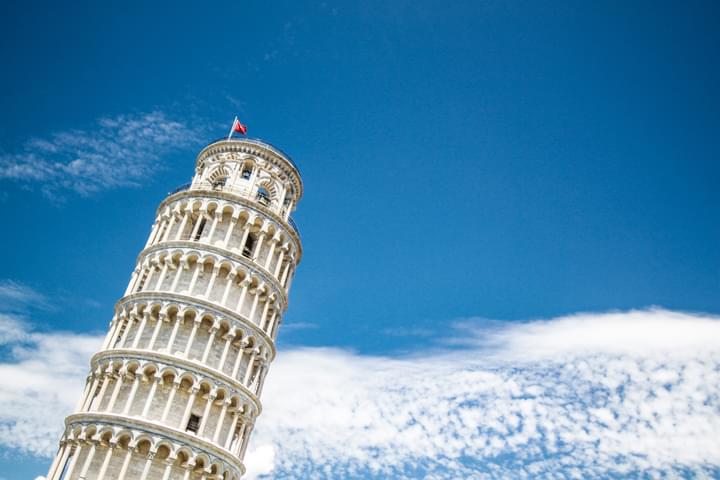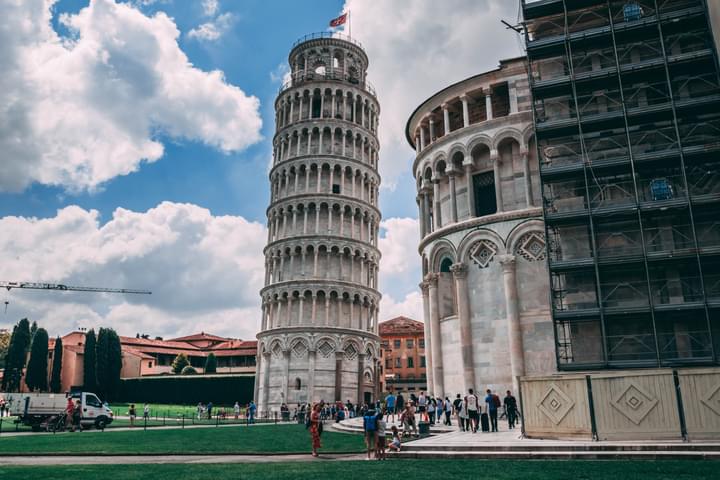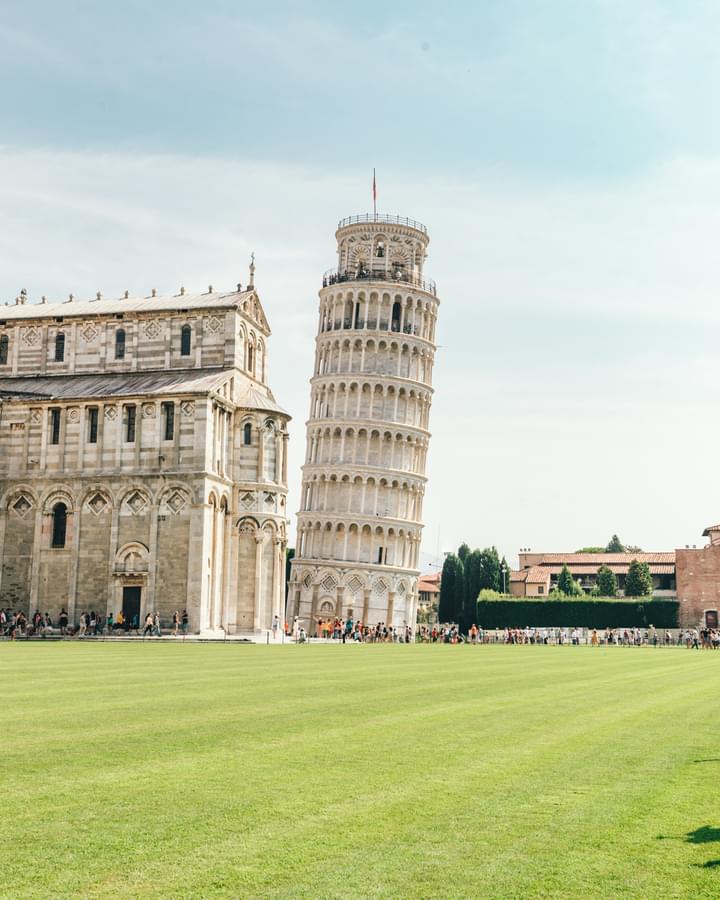Overview of Leaning Tower of Pisa
What to See on Leaning Tower of Pisa Guided Tour
The Pisa Baptistery, also known as the Baptistery of St. John, is a stunning example of Romanesque architecture located in Piazza dei Miracoli in the city of Pisa, Italy. The building was constructed in the 12th century, around the same time as the nearby cathedral and leaning tower, and is dedicated to St. John the Baptist.
The Baptistery is a circular structure with a dome and is made of white marble, with ornate carvings and intricate details throughout. One of its most impressive features is its acoustics, which are so remarkable that the Baptistery is still used for concerts and other musical events today.
Inside, visitors can marvel at the ornate pulpit, baptismal font, and stunning mosaics that adorn the walls and ceiling. The building is a testament to the artistic and architectural achievements of the period, and is considered one of the most significant Baptistries in Italy. As part of the Piazza dei Miracoli UNESCO World Heritage Site, the Pisa Baptistery is a must-visit destination for anyone interested in art, architecture, and history.
Read More: View From Top Of Leaning Tower Of Pisa
The Pisa Cathedral, also known as the Cathedral of Santa Maria Assunta, is a magnificent Romanesque-style cathedral located in the Piazza dei Miracoli in Pisa, Italy. It was constructed in the 11th century, and its impressive marble facade features intricate carvings and sculptures that tell biblical stories.
Inside, visitors can see the beautiful coffered ceiling, ornate pulpit, and intricate frescoes, including the famous depiction of the Last Judgment by Giusto de' Menabuoi. The cathedral also houses numerous valuable artworks, including the bronze door panels designed by Bonanno Pisano and Andrea Pisano.
The cathedral's architecture is a blend of Islamic, Byzantine, and Romanesque styles, and its overall design is a testament to the city's cultural and artistic richness. The cathedral is part of the Piazza dei Miracoli UNESCO World Heritage Site, and attracts visitors from all over the world who come to admire its beauty and learn about its rich history.
The Leaning Tower of Pisa is an iconic building located in the Piazza dei Miracoli in Pisa, Italy. The tower was originally designed as a freestanding campanile for the adjacent cathedral, and its construction began in the 12th century. However, due to the soft soil on which it was built, the tower began to lean during its construction, and the tilt has only increased over time.
The tower's unique architecture and design have made it a beloved icon around the world. The tower is cylindrical in shape, with eight floors and a bell chamber at the top. The tower's lean is caused by the uneven settling of the foundation, and an attempt to correct the lean in the 20th century only caused the tower to lean further. Today, the tower's lean has been stabilized through extensive restoration efforts.
The Leaning Tower of Pisa history is tied to the city's cultural and political importance during the Middle Ages, and it is one of the most visited tourist attractions in Italy. The tower's architecture, design, and history make it a symbol of human ingenuity and perseverance in the face of unexpected challenges.
Read More: Leaning Tower Of Pisa At Night
About Leaning Tower of Pisa
The Leaning Tower of Pisa's tilt can be attributed to several factors, including the soil composition, construction techniques, location, and design. One of the main reasons for the tilt is the soft, unstable soil beneath the tower. The soil is composed of a mixture of clay, fine sand, and shells, which are not strong enough to support the weight of the tower, leading to its sinking and tilting towards the south.
The tower's construction also played a significant role in its tilt. The foundation was only 3 meters deep, and the tower was built in three phases over 177 years, leading to inconsistencies in the foundation and structure. The tower's location on a hill that slopes downward towards the south also contributed to its tilt, as did its design with a narrow base and heavy top, which made it top-heavy and unstable.
Preservation efforts began in the early 20th century, including the removal of soil from the north side of the tower and the installation of weights on the south side to counterbalance the weight of the tower. These efforts have helped to stabilize the tower, which still tilts at an angle of about 4 degrees, making it a unique and fascinating monument to the ingenuity of its builders.
Book Now: Leaning Tower Of Pisa Tickets
The Leaning Tower of Pisa's tilt was a significant concern for its preservation, and various methods have been implemented to stabilize the structure. In the early 20th century, a team of engineers began working to prevent the tower from collapsing, and their efforts have resulted in the tower's continued stability to this day.
One of the primary methods used to stabilize the tower was to remove soil from the north side of the tower, where the tilt was less severe. This process involved excavating soil to reduce the amount of pressure on the north side, which helped to reduce the tilt and prevent further sinking.
Another method used was the installation of weights on the south side of the tower. The weights were placed in underground chambers and connected to cables, which were anchored to the ground. These counterweights helped to offset the weight of the tower, which had previously been pushing it towards the south.
In addition to these measures, a concrete ring was installed around the base of the tower to provide additional stability and prevent further sinking. Today, visitors to the Leaning Tower of Pisa can ascend to the top of the tower and admire the beautiful views of the surrounding landscape, thanks to the efforts of the engineers who worked to stabilize this iconic monument.
Do Checkout: Leaning Tower Of Pisa Bells
Architecture & Design of the Leaning Tower of Pisa
The architecture and design of the Leaning Tower of Pisa are unique and iconic. The tower is a cylindrical structure with a height of 56 meters (183 feet) and a diameter of 15 meters (49 feet). It was built in a Romanesque style and features eight floors, each with a blind arcade that consists of a series of arches on small columns. The tower's base is wider than its top, creating the iconic lean that has made it famous around the world.
The tower's construction began in 1173 and continued for almost 200 years due to interruptions caused by wars and a lack of funds. During its construction, it became apparent that the tower was leaning due to the soft soil on which it was built. Despite efforts to correct the lean, the tower continued to tilt, reaching a maximum angle of 5.5 degrees before stabilization efforts began.
Today, the tower's lean has been stabilized through a series of restoration projects that have included the removal of soil from the tower's base and the installation of counterweights. The tower's unique design and architecture continue to fascinate visitors from around the world, making it one of the most popular tourist attractions in Italy.
FAQs
Why does the Leaning Tower of Pisa lean?
The Leaning Tower of Pisa leans due to the soft soil on which it was built. During its construction, the tower's foundation began to sink and tilt, causing the lean that has made it famous around the world.
Click Here to Book Now: Pisa, Siena & San Gimignano Day Trip from Florence
Can you climb the Leaning Tower of Pisa?
Yes, visitors are allowed to climb the tower's 294 steps to the top to enjoy the view of the surrounding city and countryside.
How tall is the Leaning Tower of Pisa?
The tower is 56 meters (183 feet) tall at its tallest point, and it leans at an angle of 3.97 degrees.
Recommended Read: Leaning Tower Of Pisa Fall
Is the Leaning Tower of Pisa safe to visit?
Yes, the tower is safe to visit. Extensive restoration efforts have been undertaken to stabilize the tower, and it has been reopened to visitors since 2001.
How long did it take to build the Leaning Tower of Pisa?
The construction of the tower began in 1173 and continued for almost 200 years, with interruptions caused by wars and a lack of funds.
Why is the Leaning Tower of Pisa famous?
The Leaning Tower of Pisa is famous for its unique lean, which has made it an iconic symbol around the world. It is also famous for its architectural beauty and historical significance as a cultural and artistic landmark.
Also Read: Leaning Tower Of Pisa Stairs

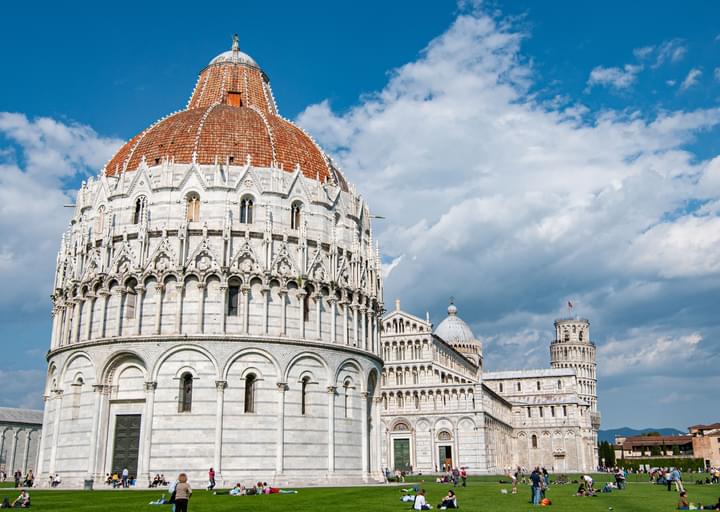
.jpg?w=360&dpr=2)
